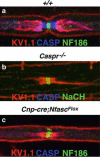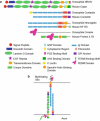Myelination and regional domain differentiation of the axon
- PMID: 19343313
- PMCID: PMC2824168
- DOI: 10.1007/400_2009_3
Myelination and regional domain differentiation of the axon
Abstract
During evolution, as organisms increased in complexity and function, the need for the ensheathment and insulation of axons by glia became vital for faster conductance of action potentials in nerves. Myelination, as the process is termed, facilitates the formation of discrete domains within the axolemma that are enriched in ion channels, and macromolecular complexes consisting of cell adhesion molecules and cytoskeletal regulators. While it is known that glia play a substantial role in the coordination and organization of these domains, the mechanisms involved and signals transduced between the axon and glia, as well as the proteins regulating axo-glial junction formation remain elusive. Emerging evidence has shed light on the processes regulating myelination and domain differentiation, and key molecules have been identified that are required for their assembly and maintenance. This review highlights these recent findings, and relates their significance to domain disorganization as seen in several demyelinating disorders and other neuropathies.
Figures



References
-
- Abe I, Ochiai N, Ichimura H, Tsujino A, Sun J, Hara Y. Internodes can nearly double in length with gradual elongation of the adult rat sciatic nerve. J Orthop Res. 2004;22:571–577. - PubMed
-
- Arroyo EJ, Xu YT, Zhou L, Messing A, Peles E, Chiu SY, Scherer SS. Myelinating Schwann cells determine the internodal localization of Kv1.1, Kv1.2, Kvbeta2, and Caspr. J Neurocytol. 1999;28:333–347. - PubMed
-
- Baba H, Akita H, Ishibashi T, Inoue Y, Nakahira K, Ikenaka K. Completion of myelin compaction, but not the attachment of oligodendroglial processes triggers K+ channel clustering. J Neurosci Res. 1999;58:752–764. - PubMed
Publication types
MeSH terms
Grants and funding
LinkOut - more resources
Full Text Sources

